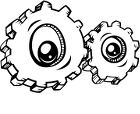
 Teacher Name: Leslie Stephens
Teacher Name: Leslie Stephens
School: South Middle School
Franklin County, TN
Grade: 6th Grade Math and
Tier 3 RTI Coach
The Challenge:
Students arrive in middle school grade levels behind in math, not because they are not smart, but because they are lacking understanding. Their number sense is missing pieces and the foundation on which they are to build abstract thinking is very shaky. They see numbers as marks on a page and have very few mental images of what a number actually looks like or how numbers relates to one another. As adults we have adapted over time to picturing numbers, but children have not had that developmental advantage. My RTI students desperately need pictures in their mind of what 2/3 looks like and how it might relate to 1.5.

As with any good intervention the proof is in the data. A group
of 22 sixth grade students were tested before using Woot Math. These students were at least two grade levels below in math understanding and application at the beginning of the year. Over eight weeks these Tier 2 and Tier 3 RTI students used Woot Math
1-2 times per week 30-40 minutes each time. Their progress was monitored every two weeks and all students showed increased understanding after 8 weeks. Eighty percent of the 22 students have gained at least one grade level of understanding since the beginning of the year.

The Solution:
My partner and I used Woot Math 2 times a week for 20-40 minutes a day for both Tier 2 and Tier 3 students. These students are up to 3 grade levels behind in their math understanding. Each student starts at the same level and helps individual students finds a personal level of success. This motivated my students to try harder each time. Woot math gives them scaffolded pictures of what each fraction, decimal, and whole number looks like and how it relates to other numbers. Woot helps students develop much needed mental images of numbers, so that they no longer need a picture to visually imagine what a number looks like.
The Result:
Tier 2 and Tier 3 students are often unmotivated because of their attitudes toward math. They did not grow weary of trying to improve their math understanding using Woot Math as they have in the past with other interactive programs. Woot is fun and engaging and my students are always excited to use Woot Math. Students love the immediate feedback and feel motivated to keep trying until all levels have” three star” learning. For the first time ever students who have not found success in math are starting to find understanding and feel successful.
Each individual student can move at their own pace. They advance when they feel comfortable moving on. However most students keep working in one area until they have achieved mastery. All students start with Making Sense of Fractions on a third grade level, but then advance through other lessons at their own pace.
The virtual manipulatives provided on Woot Math give students something to tie mental math images to and the program helps students start wherever they are in their understanding and develop skills that transition them to no longer needing those manipulatives. Woot Math is a very natural progression from concrete to drawing representations to abstract thinking.
How has Woot Math impacted your students' learning?
As with any good intervention the proof is in the data. A group of 22 sixth grade students were tested before using Woot Math. These students were at least two grade levels below in math understanding and application at the beginning of the year. Over eight weeks these Tier 2 and Tier 3 RTI students used Woot Math 1-2 times per week 30-40 minutes each time. Their progress was monitored every two weeks and all students showed increased understanding after 8 weeks. Eighty percent of the 22 students have gained at least one grade level of understanding since the beginning of the year.
Woot Math has impacted student learning in a positive way emotionally, as well. Students are always ready and willing to use Woot Math. Plus they all find success at some level. Students never seem to be bored or ask to get away from Woot Math. They are eager to learn using this tool. Students are finding it easier to draw pictures and visualize numbers, especially fractions. This is giving students more confidence with numbers. It gives them a better way to communicate thinking about problems and increases problem solving abilities. This increased understanding helps facilitate discourse and engage students who have found themselves on the fringes of regular math classes.
